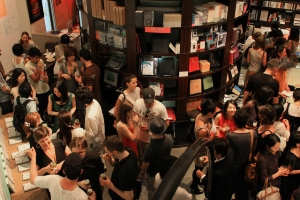There I’ve named it. Centuries from now, fans and scholars will look back at this past decade as the birth of Popularism, the movement that stamped the coffin lid on postmodernism.
I attended the Modern Language Association conference in January, and according to the “What’s On” section of The Vancouver Sun I read over my first breakfast, the city was more “erudite” than usual that weekend. Imagine 8,000 English professors converging on one city block. And yet this year’s star speaker was Sara Paretsky, “best-selling mystery writer” of the “revolutionary novels” featuring detective V. I. Warshawski. I’d spied some of her paperbacks in airport bookstores on my trip over. That’s not evidence of an academic bastion. That’s collapsed rubble.
My complimentary Sun also included an article on the Vancouver Symphony Orchestra; “the old days of new music” were “a tough slog for general audiences” but now “are over.” Instead, Jocelyn Morlock, VSO’s composer in residence, is emphasizing “pure fun” and “party atmosphere.” “To a large extent,” she explains, “new music has become more attractive to audiences because the attitude of composers themselves have changed. Composers want to connect with their audiences rather than baffling or alienating them.”
Compare that to composer John Harbison’s 1960s studies with Milton Babbitt, who New York Times Magazine editor Charles McGrath dubbed “the reigning prince of atonality.” Harbison’s “reluctance to abandon melody,” McGrath wrote in 1999, “made him an outcast. He still remembers a moment when one of his grad-school classmates turned to him and said, ‘You’re really just a tune man, aren’t you?’’” The tune man went on to win a MacArthur “genius” award, while being labelled a New Romantic, a term he hated: ‘I think ‘Romantic’ is just a cover for whether or not people like something.’”
Harbison also likened operas to literature: “there’s the literary novel and the novel that’s sold in airports. Opera is in the same place where the literary novel is.” A decade and a half later, the literary novel is nowhere near opera. It’s hanging out with those airport paperbacks now. The infectious beat of genre fiction has gone highbrow. Since winning a 1999 Pulitzer for a novel about comic books, Michael Chabon has been rehabilitating the words “entertainment” and “pleasure” as the not-so-erudite goals of literature.
In the art world, the equivalent to a catchy melody is representational painting, something Mt. San Jacinto College professor John Seed would like to see more of. In a 2013 Huffington Post blog, Seed listed 40 representational painters (culled from 135) who he’d like to see in the Museum of Contemporary Art. “Like other leading American and European contemporary museums and galleries,” writes Seed, “MOCA has narrowly defined contemporary to mean works that have their roots in Duchamp, Warhol and postmodern theory.” Instead, Seed wants the museum to “woo back the respect of its public” by acknowledging that “Postmodernism officially expired.”
That death means all airport reading can discard the “Romantic” covers. Even academic scholarship wants public respect now. The NEH announced in December a new agency-wide initiative, The Common Good: The Humanities in the Public Square, emphasizing that “the humanities belong to all the people of the United States.” Their new “Public Scholar” grant wants scholarly books “accessible to general readers” and “conceived and written to reach a broad readership.” University presses, the reigning princes of academic atonality, are joining the common people too. Last year, an acquisition editor at the University of Iowa Press contacted me to ask if I would be interested in adapting my pop culture blog into a “crossover” book designed for a general interest audience, what the press predicts will play “an important role in the future of university publishing.” As a result, On the Origin of Superheroes: from the Big Bang to Action Comics No. 1 will be out in fall 2015.
Over fifty books in comics studies were published last year—including from Oxford and Cambridge—but I’m the only person on my campus who fields the question: “Oh, are you the comic book guy?” Unlike Harbison’s graduate-school snobs though, my colleagues ask it with a pleased grin, followed by an admission of a similarly lowbrow interest of their own. As a result, I keep stumbling into interdisciplinary projects. Cognitive psychologist Dan Johnson and I have begun a second round of studies exploring the so-called division between “literary” and “popular” fiction.”Atin Basu, a professor of economics next door at the Virginia Military Institute, and I are applying game theory to zombie movies. Nathaniel Goldberg, a Washington and Lee colleague in Philosophy, and I are thinking about Alan Moore’s Swamp Thing and philosopher Donald Davidson’s Swampman. Our Art department’s Leigh Ann Beavers is teaming up with me to design a new spring course on making comics—though we may go with the more erudite title Graphic Narratives. None of these projects may be “revolutionary,” but they are “pure fun.”
A major in my English department is writing her senior thesis on Fifty Shades of Grey. And why not? It’s a cultural object worth analysis. This invasion of the popular into the serious worries some folks though. Last year, Adam Brooke Davis warned in the Chronicle of Higher Education about “the overwhelming weight of pop culture,” after discovering that his advanced creative writing students were more likely to have read The Hunger Games than short stories by Annie Proulx or Ha Jin. That was a surprise? Isn’t that the definition of “popular”? I’m not a particular fan of Suzanne Collins or E. L. James or Sara Paretsky, but I don’t object to their book sales. It’s just something else to study.
By mid-century I predict the aesthetic pendulum will start slicing back in the opposite direction. Until then, I’m enjoying the party.




